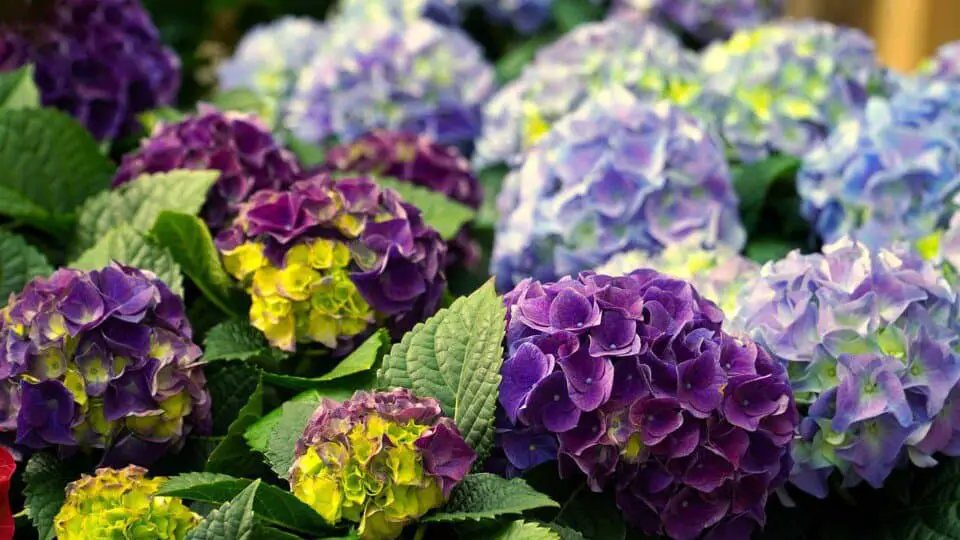Some links in the post are affiliate links and I get a commission from purchases made through some links found in the post.
Fertilizers play a major role in growing lush and beautiful hydrangeas, and with the right one, you can get optimal results from this plant.
However, with the number of products available out there, picking a fertilizer that is suitable for your plant can be overwhelming.
Some of the best fertilizers for hydrangeas are those that include the essential nutrients which are nitrogen, phosphorus, and potassium (NPK).
The fertilizers contain the appropriate amount of macro and micronutrients as well as other items that help the growth of your plant.
These fertilizers should be combined in a ratio of 10-10-10- N-P-K or 10-20-10 N-P-K.
This guide also covers some important aspects of fertilizing your hydrangeas such as; when to fertilize, the amount of fertilizer to use, and the type of fertilizer best for this plant.
We have also covered some homemade fertilizers for hydrangeas and how to use them.
When Should I Fertilize my Hydrangea?
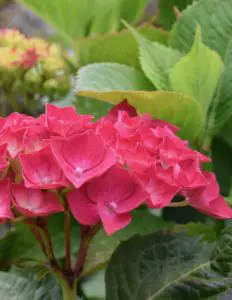 Fertilizing your hydrangeas at the right time is important for growth to occur at the right time.
Fertilizing your hydrangeas at the right time is important for growth to occur at the right time.
The best time to apply fertilizer to hydrangeas should be between mid or late spring and this range from March to May.
Application in this period is important because the fertilizers boost the growth of new leaves at this time and spring provides the ideal climate conditions to care for this plant.
Early spring fertilization is recommended for preparing this plant for the growing season and a mild fertilizer should be used during this period.
Mid-spring fertilization is done in preparation for bloom in late spring while late spring fertilization is done in preparation for early or late summer bloom.
Application of fertilizer to this plant in late spring is important to close the growing season and keep the hydrangeas healthy while they prepare for winter.
What Type of Fertilizer Should you Give a Hydrangea?
The right type of fertilizer contains Nitrogen, phosphorus, and potassium (NPK) and these substances should be combined in a ratio of 10-10-10- N-P-K or 10-20-10 N-P-K.
The high amount of phosphorus in a fertilizer encourages an increase in the quantity and size of blooms produced.
Nitrogen is important for the production of chlorophyll, the growth of important plant tissues, and aids in photosynthesis.
Phosphorus is vital for root development, stalk and stem strength, and seed development.
Potassium helps to strengthen the plant’s ability to resist diseases and the effects of pests.
These substances play an important part in the growth and overall health of your hydrangea so when the soil is deficient in one of these, your plant may lack in some areas.
Types of Fertilizers for Hydrangeas
Fertilizers for hydrangeas are available in three main forms; liquid, granules, and compressed spikes.
Liquid Fertilizers
Liquid fertilizers are the best options for quick and effective fertilization. You can get products under this category as a concentrate which will need to be diluted for use or you can get it in a form that’s ready to use.
To apply liquid fertilizers, you may be required to spray it on the foliage or pour it around the bottom of the plant, you will need to follow the directions provided by the manufacturer to know the application method.
One of the problems of using liquid fertilizers on your outdoor hydrangea is that it can be washed away by the rain and the University of California IPM cautions that over-fertilizing your soil with liquid fertilizer may add to water pollution.
Granules Fertilizers
This type of fertilizer comes in form of pellets that can be applied in two different ways.
You can dissolve these pellets in water and apply them to the base of your hydrangeas for quick effects or you can simply work the granules into the soil to form a slow release of the nutrients into the soil.
Following the instructions provided, you can determine how many granules to use for your hydrangeas.
Fertilizer Spikes
Fertilizer spikes are long capsule bundles containing the essential nutrients for your plant. Spikes are also slow release fertilizers that work when the activities of fungi and bacteria act on them.
To use this fertilizer, dig a hole in the target area of fertilization and insert the spikes, the soil has to be damp for this fertilizer to be effective.
Do not insert this fertilizer close to the base of your hydrangea as it can cause fertilizer burn to your plant.
When you apply the right quantity of fertilizer spikes, you may not be at risk of over-fertilizing as each spike contains a pre-measured amount of fertilizer.
How Much Fertilizer Should you Give your Hydrangea?
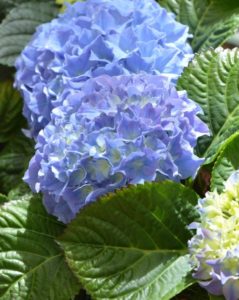 It is important to know how much fertilizer to feed to hydrangeas to prevent fertilizer burning to the roots, but several factors determine the quantity of fertilizer your plant needs.
It is important to know how much fertilizer to feed to hydrangeas to prevent fertilizer burning to the roots, but several factors determine the quantity of fertilizer your plant needs.
You need to consider the amount of organic content your hydrangeas have, if it is rich in organic contents, then you will apply a small quantity of fertilizer, but if it is lacking in organic contents, then you can apply a slightly higher amount of fertilizer.
The amount of fertilizer you apply to your hydrangeas also depends on the type you use.
For liquid fertilizer, you will be required to dilute a specified amount of fertilizer (usually 1 tablespoon) for every gallon of water or you can directly apply it to your soil.
If your choice of fertilizer is granules, then you will apply a decent amount of these pellets to your soil but this amount varies with the size of your hydrangea space.
For fertilizer spikes, you will need between 1 to 4 cylindrical capsules and just like the granules, the amount of spikes you use depends on the size of your planting area for your hydrangeas.
3 Best Fertilizers for Hydrangeas
If you are having trouble choosing from the wide range of fertilizers available for this plant, we have helped you narrow down your choices to our recommended 3 fertilizers for hydrangeas.
You can make a comparison between these 3 products to determine which one will be ideal for your hydrangeas.
1) Osmocote Smart-Release plant food
This is a granular fertilizer suitable for hydrangeas grown both indoors and outdoors and it is effective for any growing conditions.
This 8lbs fertilizer contains 11 nutrients that are essential for the health of your hydrangea and it is manufactured as a slow release fertilizer that feeds your plant gradually.
This fertilizer is coated with semi-permeable resin that allows water to penetrate it to dissolve the nutrients inside and as temperature changes affect the granules, the nutrients are released gradually.
The shell will be empty after the nutrients are out. The nutrients in these granules are released faster under warm temperatures.
Pros
- Easy to use
- Slow release fertilizer that has a long-lasting effect
- Suitable for all growing conditions
Con
- It can take longer to dissolve sometimes
2) Miracle-Gro water soluble flower food
Miracle-Gro is a highly regarded brand known for manufacturing gardening supplies and this fertilizer happens to be one of their best products.
This 1.5lbs fertilizer is affordable and is known to work miracles for hydrangeas, no pun intended.
Application of this fertilizer should be done once every two weeks and it can be mixed with other compost to help your hydrangea produce better blooms.
To use this fertilizer, mix 1 tablespoon of this powder with 1 gallon of water for an outdoor plant while an indoor plant requires ½ teaspoon per gallon of water.
Mix well and add to a watering can, soak the base of your hydrangeas with this mixture.
Pros
- Affordable and a great choice if you are working on a budget
- Stimulates fast growth of your hydrangea
- Reasonable quantity
Cons
- Continuous use is required
3) Jobe’s fertilizer spikes
This product contains 10 fertilizer spikes. This is a slow release fertilizer that has a long-lasting effect on the soil of your plant, it is recommended to be used after bloom which is late spring or early summer to strengthen your plant and prepare it for winter.
To use these spikes, insert 1 piece for each plant diameter or a 1.5 plant diameter and insert 4 spikes for a 4 feet plant diameter.
The action of moisture from the soil will help release the nutrients and unlike liquid fertilizer and fertilizer granules, these spikes cannot be washed away easily even by heavy rain.
Pros
- Slow release fertilizer that has a long-lasting effect
- Easy to store
- Easy to use
- It is not easily affected by rain
Con
- A large garden will require more spikes
Before purchasing fertilizer for your hydrangeas, there are several factors you need to take into consideration. The first is the quantity of the fertilizer, and this will matter a lot if you have a large garden of hydrangeas.
The quantity will tell you how long the selected fertilizer will last.
The second factor that should influence your decision of purchasing a fertilizer is the usage frequency.
Some fertilizers may need to be applied weekly while some will need to be applied every 3 to 6 months. To avoid the continuous purchase of fertilizer, you can consider choosing the one with less usage frequency.
How to Make a Homemade Fertilizer for your Hydrangea
Homemade fertilizers are a great option if you are working on a budget and these recipes are effective.
This fertilizer is great for flower growth as it contains major nutrients like phosphorus and magnesium and micronutrients like iron and calcium.
For this procedure, you will need 1 teaspoon of vinegar and 1 quart of water. Add the teaspoon of vinegar into the water and shake well before use.
Apply this mixture to the base of your hydrangea to provide potassium, phosphorus, magnesium, and other nutrients to your plant. You can learn more about making natural fertilizers for hydrangeas.
Are Banana Peels Good for Hydrangeas?
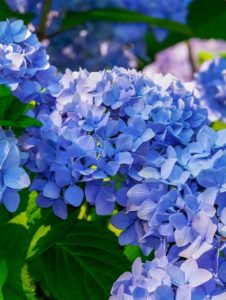 Banana peels contain nutrients like potassium and magnesium which creates a perfect growing environment for your hydrangeas. It also contains vitamins that aid in flower growth.
Banana peels contain nutrients like potassium and magnesium which creates a perfect growing environment for your hydrangeas. It also contains vitamins that aid in flower growth.
To use banana peels to fertilize your hydrangeas, you can chop the peels into small pieces and buy them in the soil of your hydrangea as they will decompose to release these nutrients.
You can equally soak these peels in water to release the nutrients and then you can apply this mixture to the soil of your hydrangea.
Are Tea Leaves Good for Hydrangeas?
Tea leaves can be used as a fertilizer for this plant and it is great for making the leaves of this plant greener.
Tea leaves contain nitrogen which is important for greener leaves, it also contains other nutrients like potassium, phosphorus, calcium, and magnesium in small quantities. This is also a productive way to utilize your tea leaves.
To fertilize your hydrangeas using tea leaves, soak the leaves in some water overnight to allow the nutrients to flow out into the water.
After letting these leaves take a good soak, strain the leaves and pour the mixture around the base of your hydrangea plant. This homemade fertilizer is also great for other plants that grow well in acidic soil just like hydrangeas.
Is Rice Water Good for Hydrangeas?
Rice water is another cost-effective method to supply nutrients to the soil of your hydrangea.
Also rice water contains vitamins and nutrients like starch which provides energy and a small quantity of nitrogen, phosphorus, and potassium which is essential for plant growth.
Rice water can be made by simply soaking uncooked rice for some hours or by collecting the water from boiled rice.
When using rice water sourced from boiled rice, you can add some water if it gets too thick, however, it is recommended that you don’t feed your hydrangea too much of this liquid as it may promote the growth of some fungal diseases.
Are Eggshells Good for Hydrangeas?
Eggshells are beneficial to hydrangeas as they are a good source of calcium which is good for proper growth, however, eggshells are only effective in powdered form, if used when coarsely ground there may be no effects on your plant.
The reason for using powdered eggshells is to make easy decomposition possible.
Heat your eggshells in an oven or microwave for about 1-2 minutes to completely dehydrate them, be careful to not burn the eggshells.
Use a blender to grind these dry eggshells into a powdered form or you can do this manually using a mortar and pestle. Pour 3-7 oz of this powder evenly around your hydrangea.
Are Coffee Grounds Good for Hydrangeas?
Coffee grounds contain a significant amount of nitrogen, phosphorus, and potassium, it also contains other micronutrients like calcium, boron, iron, and zinc.
Coffee grounds are considered to be a slow release fertilizer and to utilize them, you need to sprinkle a small amount on the soil of your hydrangea.
Do Coffee Grounds Make Hydrangeas Blue?
Coffee grounds are known for their ability to make the soil of plants acidic and they act no differently with hydrangeas.
If you are willing to do some dirty work, you can manipulate the color of your hydrangeas, and coffee grounds happen to be one of the best ingredients for this.
The flowers of this plant change their color based on their soil pH. A more acidic soil (less than 6) will cause hydrangeas to turn blue while a more basic soil (above 7) will cause your hydrangeas to turn pinkish.
Using coffee grounds will give your hydrangeas a blue color, but it is important to know that white hydrangea flowers cannot be manipulated by hydrangeas.
You may also like: How to use Baking Soda to Grow Hydrangeas
When Should you not Fertilize your Hydrangea?
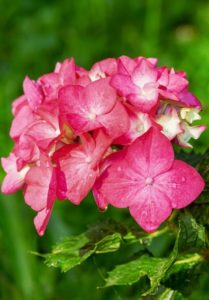 Hydrangeas prepare for dormancy during the fall making it an unsuitable time to apply fertilizers.
Hydrangeas prepare for dormancy during the fall making it an unsuitable time to apply fertilizers.
Supplying fertilizers to your hydrangeas at this time can stimulate the growth of new foliage which can be affected by the low temperature during winter.
If the new leaves of your hydrangeas are victims of frost damage, it may damage their flowering bud permanently.
Final Thoughts
Fertilizing hydrangeas can be a bit tricky, but with the right guide, you can do it right.
This article has covered when and how to fertilize this plant, as well as the best fertilizers for this plant. You can also find recommendations on some homemade fertilizers for this plant.

